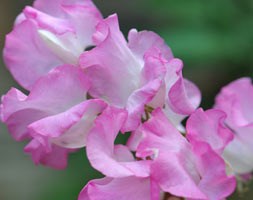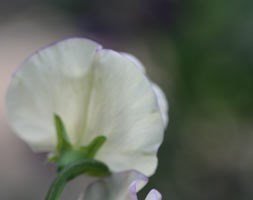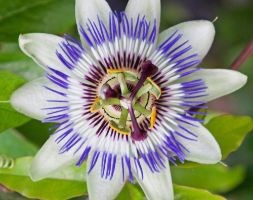Price reductions at Crocus
by Sarah - April 8th, 2014.Filed under: Crocus, Price Reductions.
Crocus has cut the price of these items
Lathyrus odoratus ‘Gwendoline’ (spencer sweet pea Gwendoline) was £6.99 now £4.99
These sweet peas are autumn sown and grown in root trainers to promote longer deep roots. They have been grown under a cold polythene tunnel and we will despatch them as soon as they are ready to be planted outside. (See the dates above for the estimated despatch date) Position: full sun Soil: fertile, humus-rich, well-drained soil Rate of growth: average to fast-growing Flowering period: June to September Flower colour: cream flushed with pink Other features: highly scented flowers Hardiness: hardy annual Creamy-white petals, which look like they have been dipped in pink icing sugar, form luscious sprays of flowers that appear in profusion in summer. This headily-scented variety looks great scrambling over an obelisk or sprawling over a hospitable, neighbouring shrub. Cut the flowers to fill your home with perfume, or leave them outside for the bees buzz about. In our (not very scientific) sweet pea trial on the nursery, we found that this variety had very pretty flower colour and was highly scented. There were not too many flowers left in August, and what there was had a stem length of around 6 – 8″. All the sweet-peas in our trial produced significantly better plants when the seeds were sown in autumn rather than spring. Garden care: Incorporate lots of well-rotted organic matter in the planting hole. To make sure you keep the plants in top condition spray regularly with a fungicide as all sweet peas are prone to mildew, and feed with a high potash fertiliser, such as Tomorite for plenty of flowers. Don’t forget to keep cutting the flowers so that you get plenty more!
Lathyrus odoratus ‘King’s High Scent’ (modern grandiflora sweet pea King’s High Scent) was £6.99 now £4.99
These sweet peas are autumn sown and grown in root trainers to promote longer deep roots. They have been grown under a cold polythene tunnel and we will despatch them as soon as they are ready to be planted outside. (See the dates above for the estimated despatch date) Position: full sun Soil: fertile, humus-rich, well-drained soil Rate of growth: average to fast-growing Flowering period: June to September Flower colour: Creamy-yellow with a violet picotee edge Other features: the flowers have a knock-out scent Hardiness: hardy annual The delicate picotee colouring of this sweet pea, coupled with the flowers unusually powerful scent, make this a beautiful addition to the flower garden. Where space is at a premium, try filling large pots with them, and top it with a woven obelisk that they can scramble over. Throughout summer you will have a stunning feature for your terrace. In our (not very scientific) sweet pea trial on the nursery, we found that this variety had the most fantastic scent of all. The flowers were held on very long stems approximately 6-9″ long, but it only has a few flowers left in August. All the sweet-peas in our trial produced significantly better plants when the seeds were sown in autumn rather than spring. Garden care: Incorporate lots of well-rotted organic matter in the planting hole. To make sure you keep the plants in top condition spray regularly with a fungicide as all sweet peas are prone to mildew, and feed with a high potash fertiliser, such as Tomorite for plenty of flowers. Don’t forget to keep cutting the flowers so that you get plenty more!
Passiflora caerulea (blue passion flower) was £12.99 now £10.99
Position: full sun or partial shade Soil: moderately fertile, moist, well-drained soil Rate of growth: fast-growing Flowering period: July to September Hardiness: frost hardy (will need winter protection in cold areas) A really exotic-looking plant, with large white flowers and central filaments of purple, blue and white from July to September, followed by egg-shaped, orange-yellow fruit. The leaves are pretty, too; deeply lobed, dark green and glossy. This blue passion flower is a vigorous, trouble-free climber that thrives in hot summers and will quickly cover a sunny wall or fence. Ideal for a tropical planting scheme, it grows best at the base of a sheltered wall in full sun, although it will tolerate some shade. The fruit are edible, but not very tasty! Passion flowers are believed to represent the suffering of Christ on the cross and the mysteries of the Passion. The 17th century monastic scholar, Jacomo Bosio, describes ‘the column rising in the centre of the flower surrounded by the thorn of crowns (and) the three nails at the top of the column. In between, near the base of the column is a yellow colour about the size of a reale, in which there are five spots or stains (stamens) of the hue of blood evidently setting forth five wounds received by our Lord on the cross.’ Garden care: Choose three to five of the strongest shoots, tying them in to horizontal wires. Once the plant is established, cut back the flowered shoots immediately after flowering to within two or three buds of the permanent framework of the plant. In spring remove dead, misplaced or overcrowded stems.









